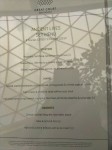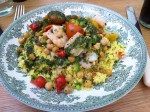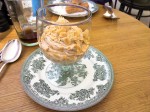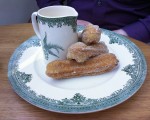Today on Food on Fridays we’re in London, eating “ancient food” at the British Museum.
Before this trip, I always thought that it was possible to get a taste of ancient history at The British Museum by seeking out the Rosetta Stone or the Egyptian mummies. But the sit-down restaurant at the British Museum offers a 3-course set lunch called “Ancient Lives”. The restaurant is just steps away from one of the galleries that houses collections from ancient cultures: Assyrian, Egyptian, Hittite. You name the ancient culture, they’ve probably got a statue, a cuneiform tablet, and/or a game board or two from there in those galleries. So I assume it’s that proximity that has prompted the name of this menu; there was no claim on the menu that the recipes came directly from the cuneiform or hieroglyphs on the tablets.
Anyway, after spending a morning visiting a few of those exhibits on our recent visit to London, Chris and I were ready for lunch. On previous visits, we’ve always gone to the lobby of the British museum for our food breaks. There’s a small serve-yourself-style cafe where you can get a sandwich and a cup of tea, and fight for space and a small stool at long shared tables. However, as we debated what to do for lunch, we realized we were literally standing in between the ancient exhibit galleries and the museum’s sit-down restaurant. So, we checked out that menu just for fun. Although most of the menu seems a bit overpriced and mundane, this special “Ancient Lives” menu seemed intriguing, and we decided to try it.
There were 3 options for each of the 3 courses, of which we were able to sample 2 different things for each course. To start, we had the vegetable sambosa and the seared tuna; for the entrée we selected the tiger prawns and the lamb options, much of which came with couscous, so I could kind of see the Middle Eastern connection to those dishes. (The complete menu is in a photo below).
For dessert we had date and almond fool, and also orange-scented beignets. “Fool” is a traditional English dessert; i guess the dates and almonds were the nod to the ancients. Beignets? They are doughnuts by any other name, IMHO. ;-). I actually recall a story about ancient cultures and doughtnuts, BTW. My M.A. and Ph.D. advisor used to tell a story at parties about how Proto Indo-European (PIE) words get reconstructed from words that are similar linguistically, but which do not necessarily have the same meaning. For example, there’s a PIE word that is reconstructed from words whose meaning generally refers to something that is a circle with a hole in it; in some languages it came to mean “wheel”. In one language, it meant “toilet seat”.
But in Hittite, it meant “doughnut”.
Now, my Hittite is rather rusty, as it’s been 28 years since I wrote my M.A. thesis about an issue in Hittite linguistics. I thought I might be misremembering the story about the circle with a hole in it word, but then I actually found this vocabulary list for PIE that lists a word that means “wheel” in many languages, and “donut” in Hittite. So, perhaps that is why a type of doughnut is on the “Ancient Lives” menu at the British Museum.
Well … it could be the reason, at least. Whatever the case, the beignets were delicious.
Actually, everything was very good, and some things (like the lamb, the fool, and the beignets) were extremely good. All in all, it was by far the best lunch of the trip, and ranks up near the top of all the meals we had in our 2.5 weeks of roaming. Considering we had some pretty tasty meals in both London and Paris this time, that’s saying quite a bit.
In the photo gallery below, in addition the menu, you’ll find photos of the second and third courses. There are no photos of the first course, as I didn’t think to take photos before we’d finished those dishes.
But hey — when you study ancient history, the written record is always at least a little bit incomplete…
- “Ancient Lives” menu, British Museum Restaurant
- Entrance to the galleries of ancient objects
- Tiger prawns and chickpea salad
- The Friendly Tourist and the Marinated Lamb
- Date and Almond Fool
- Orange-scented Beignets







Thank you for the interesting excursion into Hittite and Indo-European. Blog posts that come with etymologies are as big a treat as donuts.
Enlightening post and the food looks good too. I’m glad I read this after I had lunch.
Thanks for the comments!
@Will, the next question is when did “donuts” become so widespread as to be used instead of “doughnuts” in PIE word list, I wonder. Of course, in Tübingen, “donut” always refers to a doughnut with a hole in the middle.
Interesting question, but I’m not going to do the research–why bother when we can draw on anecdotes? My mother spelled “donut” with the full word “dough,” while I never did. I’m guessing that a Google Ngram would show a gradual transition, with maybe a turning point around the time that Miller Lite was introduced.
Does that sound rite?